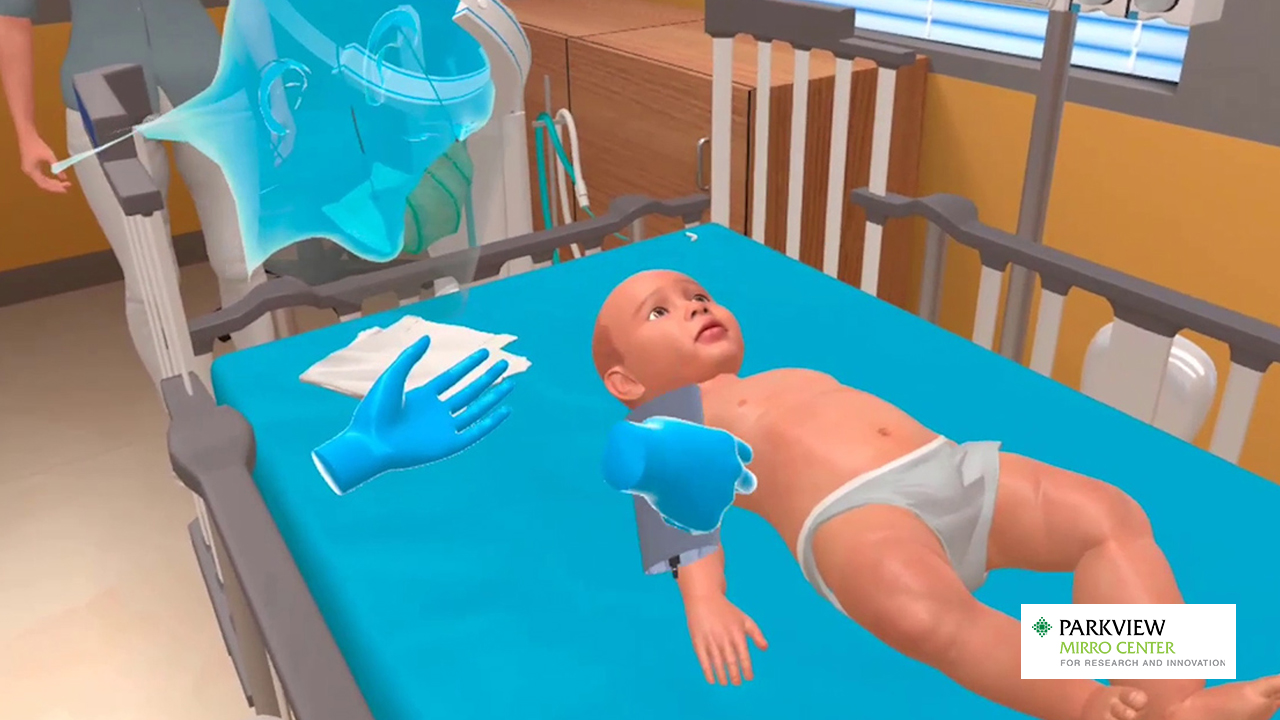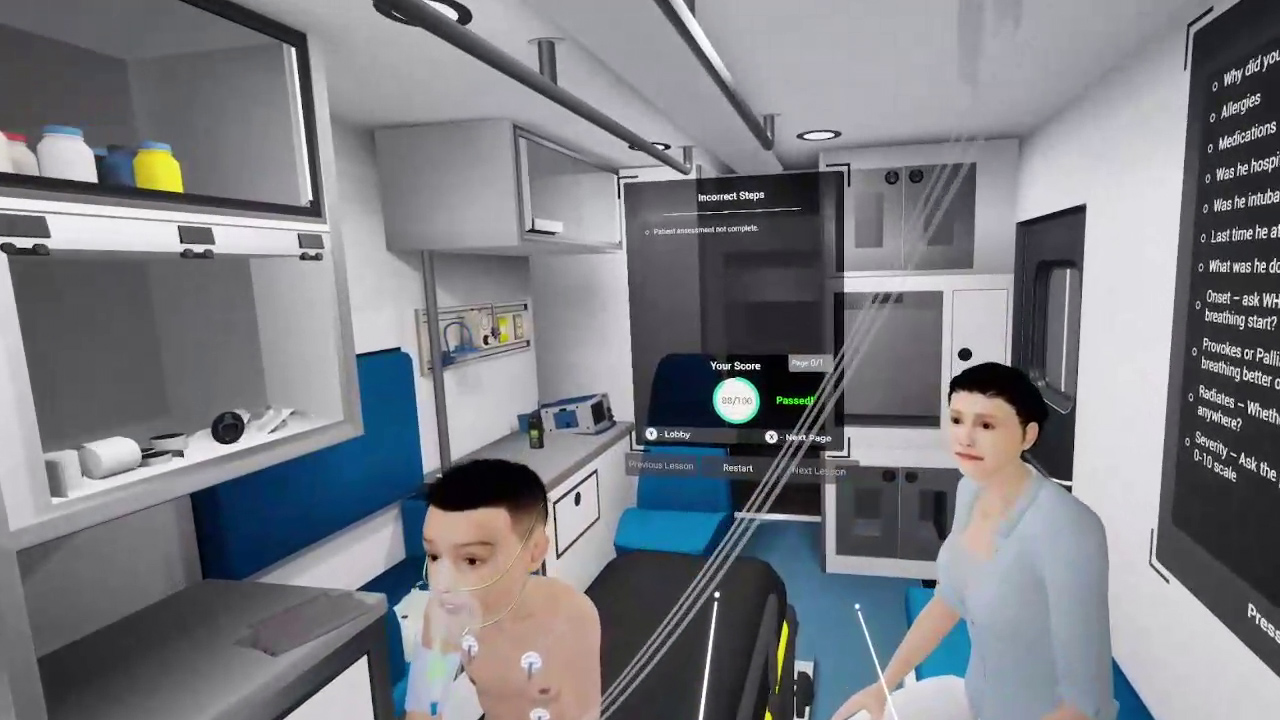
Parkview Mirro Center for Research and Innovation partnered with MedVR Education to understand, analyze, and compare knowledge change, confidence, and simulation attitudes with asynchronous VR simulations to traditional, high-fidelity, in-situ simulations. Traditionally, manikins have been playing a crucial role in bridging the gap between theoretical and practical knowledge. However, the advent of VR has brought about significant changes in the training environment. When it comes to the pediatric domain, the level of complexity is usually high compared to adults. Not only are the stakes higher, there is the emotional dimension as well. This makes it increasingly important to provide high quality training opportunities.
Traditional training approach with manikin-based simulations
Manikins have been an important part of healthcare training as they provide a controlled and safe environment to learn and practice medical procedures. Over the years, with improved technology, sophisticated manikins capable of providing physiological responses have been developed. This has helped bring about an increased level of realism in training experiences. Undoubtably, the physical aspect of providing a tangible, hand-on experience required for procedures like IV insertions, intubation and CPR is highly advantageous with manikin-based training. However, the training mode has its limitations. They are not able to replicate the emotional responses of patients, which is very crucial when it comes to pediatrics. Additionally, some pediatric conditions are difficult to simulate in manikins, like dynamic airway responses as one may witness in a case of severe asthma.

Managing a case of pediatric asthma is VR.
VR-based healthcare simulation training
Virtual reality has been around for some time and was primarily associated with gaming but is now rapidly advancing in the training domain, particularly in healthcare. The need for realistic, effective and immersive training for healthcare procedures and scenarios is of paramount significance as better training opportunities will lead to an efficient and well-trained healthcare workforce. So, what is it that makes VR-based training so effective? We can attribute that to a couple of factors.
Realistic replica of real-world scenarios – The more realistic a training session is, the more effective it is. When it comes to VR training, the environment and scenario is digitally created. This means that every aspect of the scenario can be modified and customized as per the need of the case. When learners train in a realistic virtual environment, there is a high level of immersion, engagement and retention.
Anytime, anywhere training – VR training helped open the possibility that healthcare training need not be limited to elaborate training facilities with physical tools and equipment. With VR, all that a learner needs are a headset and some space. Simulations are equipped with tools, equipment and a virtual patient to provide thorough training, anytime, anywhere. As it is revealed by initial finding of the Parkview study, night shift staff “report appreciating having education that is accessible.” This makes it possible for them to further their training along with maintaining a balance with their working hours.
Integration of AI and haptics– Artificial intelligence has upped the realism in the virtual world. Characters are now powered by AI making them respond and react like real humans. Unlike manikins, virtual characters show emotional and physiological changes providing learners with an experiential training session. Haptic gloves have narrowed the line between real and virtual by enabling tactile feedback, a significant step in VR simulation for healthcare training.
Real-time feedback – Changes in patient conditions call for changes in procedures, critical thinking and tapping into clinical judgment skills. Virtual characters in the MedVR Education simulations respond to treatment procedures, improvement if the correct procedure followed, and deterioration if a wrong step has been taken. This realistic change in patient condition provides real-world training. When the condition of a pediatric bronchiolitis patient starts getting bad, the learner must analyze the situation and based on clinical-judgment skills, decide on what course of action to take.
Study with Parkview
The Parkview study into the comparison of manikin-based training and VR simulation training is in the initial stages. The grant for this study is provided by INSPIRE (International Network for Simulation-based Pediatric Innovation, Research, & Education). So far 43 learners have participated in the study, with the interventional learners consisting of night shift providers, nurses, and respiratory therapists working in both pediatric acute and critical care units. The same professionals working day shift received one-time high-fidelity simulation.
Being a new and evolving technology, VR like any other piece of development, gets its share of reluctance and hesitation from first time users. There is always a learning curve involved and the same was witnessed in this case with users hesitating to engage voluntarily. They did so only when technical support was provided.
Thus far “modest knowledge change has been witnessed pre and post simulation surveys” and an extended period of solution experience will reveal a clearer picture of the effects of VR simulation training. Until now, the results point in a positive direction showing a promising trend in the adoption of VR as a means of training and practice in healthcare procedures and scenarios.
About MedVR Education:
MedVR Education is a continuing education platform, founded with the specific aim of providing immersive and engaging VR training solutions to healthcare professionals. Its dynamically growing library witnesses the addition of 4-5 new solutions every month. MedVR Education is at the forefront of implementing the latest technology in the field of VR and training, ensuring that learners get the best possible learning experience.
Contact us to know more about VR in healthcare training or visit MedVR Education to explore the various programs we offer.

